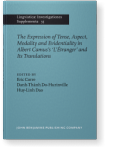Chapter 11
Les temps verbaux et l’ancrage énonciatif en français et en
estonien
L’exemple de L’Étranger d’Albert Camus et de
sa traduction
This article compares the linguistic means used
for enunciative anchoring in the French and Estonian texts of the
novel L’Étranger. The use of the French perfect in
narration ensures the implication of the utterer throughout the text
and, on the other hand, the mobility of the narrative voice brings
about constant shifts between the current present discourse and
narration. The Estonian verb system is neutral regarding the
opposition between utterer-bound and distanced mode of narration.
This article examines how the translator deals with these
differences, in order to find out what kind of compensatory
mechanisms are needed in Estonian for expressing the peculiarities
of the enunciative anchoring of the novel and to what extent it is
possible to maintain its specific narrative features in the Estonian
translation.
Article outline
- 1.Introduction
- 2.Les ancrages énonciatifs dans L’Étranger
- 3.Les restrictions du système aspectuo-temporel estonien
- 4.Les ancrages énonciatifs dans la traduction
- 5.Remarques conclusives
-
Remarques
-
Abréviations
-
Références
Article language: French
